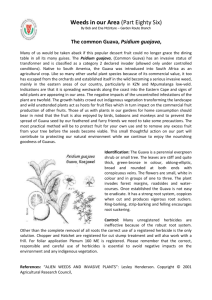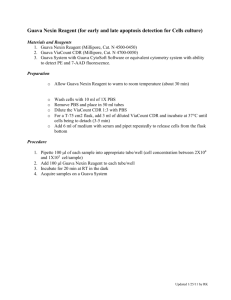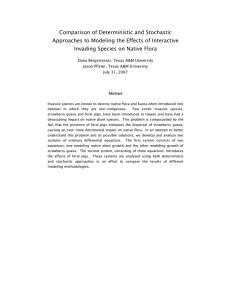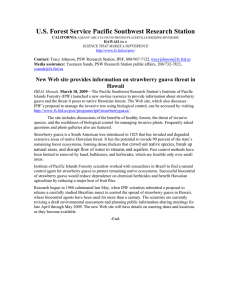The Ubiquitous Guava
advertisement
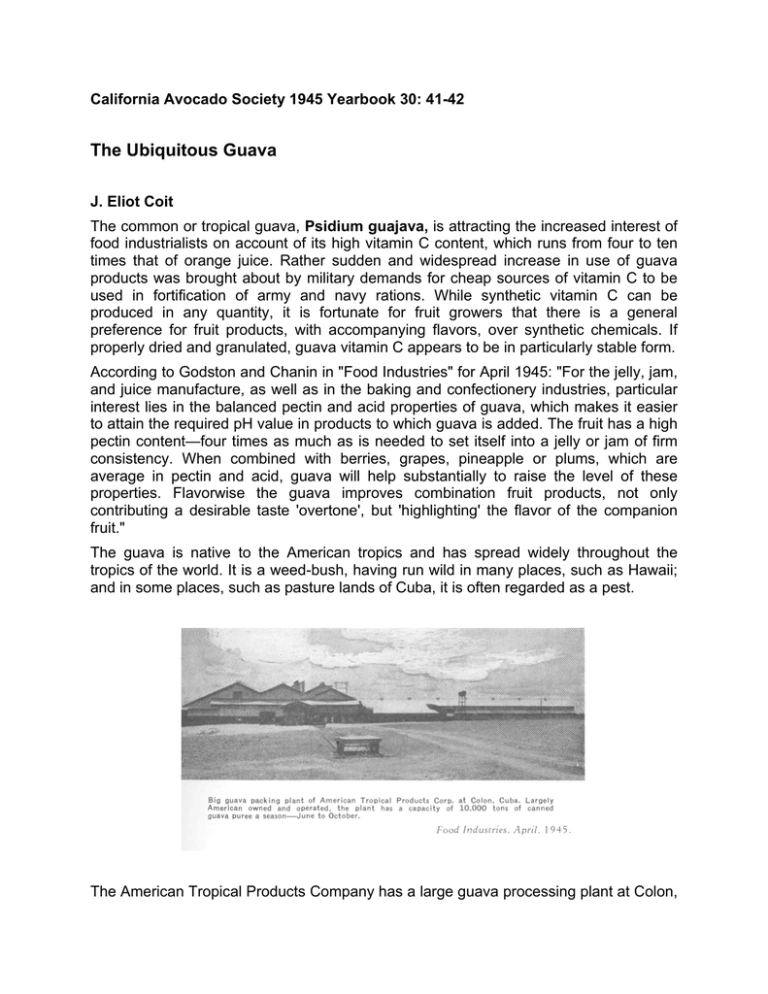
California Avocado Society 1945 Yearbook 30: 41-42 The Ubiquitous Guava J. Eliot Coit The common or tropical guava, Psidium guajava, is attracting the increased interest of food industrialists on account of its high vitamin C content, which runs from four to ten times that of orange juice. Rather sudden and widespread increase in use of guava products was brought about by military demands for cheap sources of vitamin C to be used in fortification of army and navy rations. While synthetic vitamin C can be produced in any quantity, it is fortunate for fruit growers that there is a general preference for fruit products, with accompanying flavors, over synthetic chemicals. If properly dried and granulated, guava vitamin C appears to be in particularly stable form. According to Godston and Chanin in "Food Industries" for April 1945: "For the jelly, jam, and juice manufacture, as well as in the baking and confectionery industries, particular interest lies in the balanced pectin and acid properties of guava, which makes it easier to attain the required pH value in products to which guava is added. The fruit has a high pectin content—four times as much as is needed to set itself into a jelly or jam of firm consistency. When combined with berries, grapes, pineapple or plums, which are average in pectin and acid, guava will help substantially to raise the level of these properties. Flavorwise the guava improves combination fruit products, not only contributing a desirable taste 'overtone', but 'highlighting' the flavor of the companion fruit." The guava is native to the American tropics and has spread widely throughout the tropics of the world. It is a weed-bush, having run wild in many places, such as Hawaii; and in some places, such as pasture lands of Cuba, it is often regarded as a pest. The American Tropical Products Company has a large guava processing plant at Colon, in the east-central part of Matanzas Province, Cuba. In 1944 this plant shipped 250,000 pounds of concentrated guava jelly base, and three million pounds of other guava products. This is in addition to the 8 to 10 million pounds processed in other Cuban plants. All of this production comes from wild guava bushes. In 1944 the wild guava supply in Cuba was estimated at 200 million pounds. Dr. Wilson Popenoe writes (letter dated June 3, 1945) —"Prom a short distance east of Habana way out to Camaguay and probably beyond, the pastures are full of guava bushes. If I recall correctly, the cattle men have found them a pest in many places. While I have traveled pretty widely in Cuba, I don't recall ever having seen a cultivated plantation of guavas of any size or importance". Again according to Popenoe, in "New Crops for the New World", p. 21, 1945: "The ubiquitous guava is the ugly duckling of its tribe. The bush is so common throughout tropical America as to be a weed in many places, and it takes a very courageous soul to go into ecstacies over the merits of the fruit". Many different guava products are exported from Cuba. Aside from jams, jellies, syrups, dried powder and juice; a highly concentrated puree or paste is finding increased use in this country as a component part of various confections, notably children's candy bars. An attractive flavor is added, to say nothing of the benefits of greatly increased child intake of vitamin C (Orange growers please note). However, it is all to the good if the guava is to contribute increasingly to an improved health level of the population as a whole. When we add to the potentialities of Cuba that of Brazil and other Latin American countries, to say nothing of all the other tropical regions of the world, one is impressed with the enormous present available supply. Just what opportunity is there, if any, in commercial guava culture in California? This tropical fruit requires a large number of heat units for attainment of quality. Such conditions are rarely found in coastal areas. In the few locations in the interior where there is sufficient heat, freedom from frost, good soil and abundant irrigation water, land is very high priced because of its suitability for citrus. Dr. H. J. Webber has experimented with methods of asexual propagation of improved varieties, and finds it not only difficult but the large number of plants required per acre emphasizes this difficulty. California wages and other costs including irrigation water are very high compared with such costs in Cuba and elsewhere. Would it not be more logical to plant such suitable California lands to avocados or citrus, or some other subtropical fruit which may not have to compete to the same extent with a wild product? We have never even attempted to compete with Cuba in the production of West Indian type avocados: but by advertising, standardizing, distribution, etc., have brought about a consumer preference for Guatemalan type avocados which grow to perfection in California, but with great difficulty and to a very small extent in Cuba. Perhaps we should, in a few favorable locations, grow guavas in the home garden. We might even sell some surplus as fresh fruit to the Mexican people in our cities. But as both climatic and economic conditions are so much against us, it would seem that commercial guava production for manufacturing purposes is out of the question as far as California is concerned.
